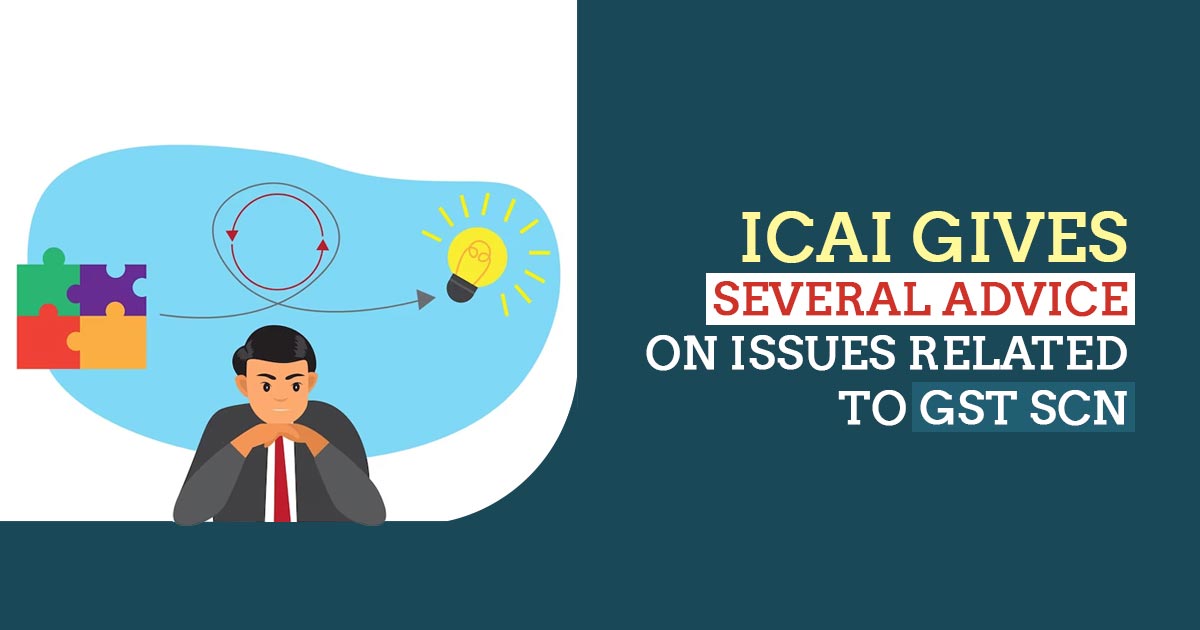
The Institute of Chartered Accountants of India (ICAI) furnishes a representation to the Shri Rakesh Agrawala, Principal Commissioner of State Tax (Government of Assam) on Mass SCN issued by the GST Department in September 2023.
The pertinent Text of the Representation is been Provided Below-
The Institute of Chartered Accountants of India (ICAI) was established on July 1, 1949, through the Chartered Accountants Act of 1949, a legislation passed by the Indian Parliament. It serves as a statutory authority responsible for the regulation and advancement of the Chartered Accountancy profession in the country. The Institute operates under the administrative oversight of the Ministry of Corporate Affairs, with a presence that includes 5 Regional Councils, 171 Branches covering the nation extensively, as well as 47 Chapters and 34 representative offices spanning 81 cities in 47 countries around the world.
During the introduction of the Goods and Services Tax (GST) system, it was widely recognized that the enactment of this new law might entail some practical implementation errors. Moreover, in the initial phase, the GST portal was not fully prepared, leading to several technical hitches for stakeholders. These challenges made it challenging for them to log in, make tax payments, submit timely returns, provide accurate self-assessment data, and rectify or amend errors when they were identified. The technical problems also resulted in incorrect filings of GST returns. In response to the numerous concerns and complaints expressed by stakeholders regarding these issues, the government assured, through various platforms and forums, that it would adopt a more lenient approach when considering genuine mistakes or errors made during the initial implementation of the law.
Make Your CA Firm Website as per ICAI Guidelines in a Low Price
Nevertheless, the Department has already commenced investigations in accordance with the prescribed methods under the GST framework. Notably, a substantial number of notices have been generated for the fiscal year 2017-18, relying on auto-generated data sourced from the information technology infrastructure and software tools. These notices primarily pertain to the recovery of alleged shortfalls in GST payments, the reversal of Input Tax Credit (ITC) due to discrepancies in Tables A and 8B of GSTR 9, ineligibility of ITC as per section 17(5) and rules 42/43, and issues related to inconsistencies in output GST liability between GSTR 3B, CSTR9, and GSTR 1 under the Central/Assam Goods and Services Tax Act, 2017. It’s worth noting that the majority of these notices were issued in the final days of September 2023, which coincided with the extended deadline for notice issuance.
These notices seem to have been issued hastily and uniformly, without due consideration of the unique circumstances of each case. They have been dispatched to all taxpayers, irrespective of their business nature and the information provided in their self-assessment returns. Unfortunately, it appears that the essential legal prerequisites have not been adhered to, and the notices appear to have been mechanically issued at the eleventh hour.
Read Also: Advisory of ICAI’s Multipurpose Empanelment Form 2023-24
Stakeholders have raised concerns about the vague and incomplete nature of these notices, which do not fulfil the essential requirements of a proper show-cause notice as outlined in section 73/74 of the CCST/Assam CST Act. It appears that these notices are issued without sufficient reliance on supporting documents or findings communicated to the taxpayers, primarily relying on auto-generated numbers, which may lack reliability in most cases. Our observations regarding these notices are as follows:
- The notices are based on GSTR-9 filings for the FY 2017-18. However, when corrections or rectifications have already been made in GSTR-9/9C, and DRC-03 has been filed to address the issues, these actions are not taken into account when issuing these notices.
- In cases where an ASMT 10 notice is sent to a taxpayer and a response has already been filed in ASMT 11, along with an Order issued in ASMT 12, these actions are not considered when issuing new notices.
- Some instances involve ASMT 10 notices being issued, and responses filed in ASMT 11, but proceedings have not been concluded, meaning that an order in ASMT 12 has not yet been issued. Despite the ongoing proceedings under section 61, notices are issued without acknowledging this fact.
- Even in cases where a DRC 01 notice has been previously issued (either by the State GST or Central GST authorities) under section 73 or section 74, new DRC 01 notices are issued based on auto-generated figures without any reference to prior proceedings or notices. Additionally, reasons for the necessity of a new notice still need to be provided.
- Despite the completion of a GST audit under section 65, carried out by either COST or SCST, with the issuance of a DRC 01 and ADT-02 to conclude the audit, and no outstanding audit issues remaining, further notices have been issued without any reference to the section 65 proceedings.
- In cases where enforcement activities have been conducted, either by SCST or CCST, resulting in the issuance of a show-cause notice, additional notices have been sent without acknowledging ongoing or completed enforcement proceedings, and without providing reasons for their necessity.
- Even when a registered individual is already in the appeal stage for FY 2017-18 on a particular matter, a DRC-01 notice for the same issue is issued.
- Notices for the reversal of Input Tax Credit (ITC) based on a total ITC claim being treated as “Common Credit” in an arbitrary manner have been issued. It appears that the approach adopted in this regard is flawed, as it considers total ITC as a common ITC, whereas, in most cases, it should be ITC after considering rule 42 or specifically related to Taxable Supplies (TTC). This has led to the inclusion of exorbitant and unrealistic amounts that need to be excluded to calculate reversals under rules 42 and 43. Additionally, certain items not subject to GST have been taken into account for the calculation of reversals under rules 42 and 43.
- Numerous instances of DRC-01 issuance under section 17(5) of CGST/SGST have occurred without due consideration of the specific exclusions stipulated in section 17(5). Presently, DRC-01 notices are solely predicated on the HSN code provided by the supplier for invoices listed in the taxpayer’s GSTR-2A, regardless of whether the taxpayer has availed credit and their business’s nature.
- Many notices have been served based on disparities between the tax declared and the tax paid in cash or through ITC adjustments as per Form GSTR 9, without accounting for situations where higher amounts in GSTR 1, compared to GSTR-38, were rectified in later GSTR 1 filings or any errors made in GSTR 1 and GSTR 3B, which were subsequently corrected in returns filed in subsequent periods or GSTR 9.
- In all instances, notices have been issued concerning discrepancies in ITC between GSTR 38 and Table SA in GSTR 9. However, GSTR 2A was not available and thus not applicable during the fiscal year 2017-18. The figures auto-populated in Table 8A were only accurate up to a specific date, which is not defined as a cutoff date in any provision of the GST law. In reality, for the period spanning from July 2017 to March 2018, the eligibility for claiming ITC was contingent only upon the conditions specified in section 16(2) (as applicable at that time). Regrettably, this fundamental fact has been overlooked, and notices have been served, erroneously asserting that ITC reflected in Table 8A of GSTR 9/GSTR 2A constitutes a requirement for eligible ITC under section 16(2).
Concerning the Aforesaid Provision We Urge as under-
- It is recommended that a structured process be put in place to prioritize the resolution of the aforementioned categories of cases, as explained above. This should involve dropping the demand made in the notices without necessitating a response from the taxpayer or the appearance of stakeholders, provided that the identified defects or weaknesses in the notices, as highlighted previously, are confirmed. Notices should be retracted without requiring the physical presence of the taxpayer or their representative, with a notification sent to the taxpayer to prevent unnecessary litigation and save productive time for all concerned parties. However, in cases where the Department determines that the notices were legitimately issued, the proper officer should be directed to follow the legal procedure and initiate or continue proceedings, but only after issuing a proper show-cause notice to the taxpayer.
- It is suggested that a standardized operating procedure be established for addressing such notices and communicated to all subordinate offices. Additionally, a special unit comprising senior officials may be formed to meticulously review such notices, with instructions provided to officers not to take any action based on mass-issued notices until the proposed mechanism is in place.
- To circumvent unnecessary legal disputes, a unique process should be adopted in situations where a business is closing or in cases where a registered individual has passed away, and the registration has been voluntarily surrendered with the filing of a final return.
- It is recommended that explicit directives be given to the proper officer to provide adequate time and grant a personal hearing in all cases while ensuring that the principles of natural justice are strictly adhered to. When requested, relevant documents should be made available to taxpayers to facilitate their compliance.
- A proposal should be forwarded to the GST Council, urging the waiver of interest and penalties on all demands stemming from these notices for the fiscal year 2017-18, as an amnesty measure, in light of the commitments made by the Government during the initial years to support the stabilization of GST across the country.
Moreover, considering that the deadline for issuing show cause notices for FY 2018-19 under section 73 of CGST/Assam GST Act also expires on or before 31.12.2023, we kindly request that the aforementioned concerns be addressed before the issuance of notices for FY 2018-19. This proactive approach aims to reduce litigation and promote a business-friendly environment in the state of Assam.
For your reference, we have enclosed Instruction No. CCT/0707/10/2023, dated 11-10-2023, issued via the Additional Commissioner (Administration), State Taxes, Gujarat, about similar notices issued based on the III Big Data Software.
We earnestly request your thoughtful consideration of the above representation, which is intended to benefit both taxpayers and revenue, from a comprehensive view.







